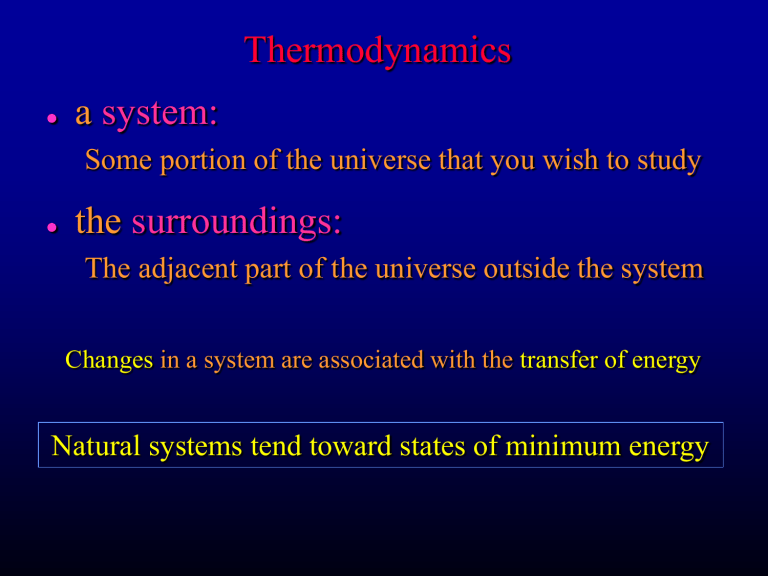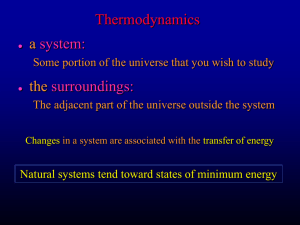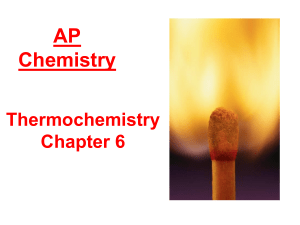
Thermodynamics
a
system:
Some portion of the universe that you wish to study
the
surroundings:
The adjacent part of the universe outside the system
Changes in a system are associated with the transfer of energy
Natural systems tend toward states of minimum energy
Energy States
Unstable:
falling or rolling
Stable:
at rest in lowest energy state
Metastable:
in low-energy perch
Figure 5-1. Stability states. Winter (2001) An
Introduction to Igneous and Metamorphic Petrology.
Prentice Hall.
A review of basic thermodynamics: A refresher
The ball represents mass exchange
The arrow represents energy exchange
The First Law of Thermodynamics
• Heat and work are equivalent
• Energy is conserved in any transformation
• The change of energy of a system is independent of the path taken
Energy can be neither created nor detroyed
D
E = q - w or dE = dq - dw dE = dq - P dV
E = internal energy q = heat w = work
P = pressure
V = volume
Enthalpy
dE = dq - P dV
H = E + PV dH = dq
H = enthalpy
The change in the enthalpy of a system (
D
H) during a reversible change in state at constant pressure is equal to the heat absorbed by the system during that change in state.
The enthalpy of formation of compounds and their ions and molecules in aqueous solution is the heat absorbed or given off by chemical reactions in which the compounds, ions, and molecules form from the elements in the standard state (25°C, 1 atm)
Heats of Reaction
D
H =
S nH (products) -
S nH (reactants) n = molar coefficient of each reactant/product
When
D
H is positive , the reaction is endothermic (heat flows from the surroundings to the system);
When
D
H is negative , the reaction is exothermic (heat flows from the system to the surroundings
Heats of Reaction
D
H =
S nH (products) -
S nH (reactants)
For example, evaporation : H
2
O(l) H
2
O(g)
D
H = H
(H2O(g))
- H
(H2O(l))
D
H = (-57.80) - (-68.32) = 10.52 kcal
The reaction is endothermic (i.e., sweating is a mechanism for cooling the body)
Heat Capacity
When heat is added to a solid, liquid, or gas, the temperature of the substance increases: dq = C dT dq = dH dH = C dT, at constant pressure (important in geochemistry)
C = heat capacity
T = temperature
Heat capacities vary with temperature…
The Second Law of Thermodynamics
• It is impossible to construct a machine that is able to convey heat by a cyclical process from one reservoir at a lower temperature to another at a higher temperature unless outside work is done
(i.e, air conditioning is never free)
• Heat cannot be entirely extracted from a body and turned into work
(i.e., an engine can never run 100% efficiently) — a certain fraction of the enthalpy of a system is consumed by an increase in entropy
• Every system left to itself will, on average, change toward a condition of maximum randomness — entropy of a system increases spontaneously and energy must be spent to reverse this tendency
The entropy of the universe always increases or
“You can’t shovel manure into the rear end of a horse and expect to get hay out of its mouth”
Entropy
D
S =
S nS (products) -
S nS (reactants)
For example: H
2
O(l) H
2
O(g)
D
S = S
(H2O(l))
- S
(H2O(g))
D
S = 45.10 - 16.71 = 28.39 cal/deg
When
D
S is positive, entropy of the system increases with the change of state;
When
D
S is negative, entropy decreases
The fundamental equation of thermodynamics
The ratio of heat gained or lost to temperature will always be the same, regardless of path, for a reversible reaction dE = T dS - P dV
When dE = 0, T dS = P dV dS = dq/T = P dV/T
Look familiar?
dP dT
= D
D
S
V dS = dq/T — reversible process dS > dq/T — irreversible process








